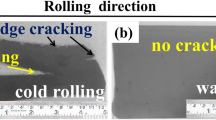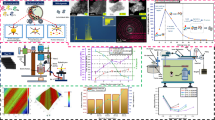The tribological characteristics of the Fe–W–CaF2 composite antifriction material (CAM) in combination with 1Kh18N9T steel are examined in air at a temperature of 500°C, a pressure of 0.8 to 3.3 MPa, and a sliding velocity of 0.5–2.0 m/sec. It is established that the friction coefficient, mass wear Im, and linear wear Il of the composite decrease, respectively, from 0.3 to 0.26, from 5 to 2 mg/km, and from 30 to <5 μm/km at constant pressure (0.8 MPa) with increase in the sliding velocity from 0.5 to 2 m/sec. At a constant sliding velocity (0.5 m/sec), with increase in pressure on the tribological system from 0.8 to 3.3 MPa, the friction coefficient f decreases from 0.3 to 0.26, whereas its mass wear Im and linear wear Il increase from 5 to 8.4 mg/km and from 30 to 57 μm/km. It is shown that secondary lubricating films form in friction on the working surface of the material. Like the starting material, they have a microheterogeneous structure and determine antifriction properties. The bcc solid solution of tungsten in α-iron hardened by inclusions of iron tungstate is a bearing structural component of the secondary lubricating films, and inclusions of iron oxides and calcium fluoride are antifriction structural components. The presence and content of the phases as well as the percentage of structural (antifriction and bearing) components in the secondary lubricating films depend on friction conditions (P · V). With increasing amount of the bearing structural component in the secondary film, wear of the material decreases. Higher content of the antifriction structural component in the film decreases the friction coefficient of the material.


Similar content being viewed by others
References
I. M. Fedorchenko and L. I. Pugina, Sintered Composite Antifriction Materials [in Russian], Naukova Dumka, Kiev (1980), p. 440.
V. N. Miroshnikov and Yu. F. Shevchuk, “Choice of solid lubricants,” Powder Metall. Met. Ceram., 10, No. 11, 911–915 (1971).
Okage Sai and Okage Masahiko, Japan Patent 48-17684, Complex Materials Resistant to High-Temperature Oxidation in Air and Containing Fluorides as Lubrication [Russian translation], publ. 31 May (1973).
I. M. Fedorchenko, Yu. F. Shevchuk, and V. N. Miroshnikov, USSR Inventor’s Certificate 433234, Antifriction Cermet Iron-Based Material [in Russian], Bulletin No. 23, publ. (1974).
L. I. Pugina, I. M. Fedorchenko, et al., USSR Inventor’s Certificate 456015, Sintered Antifriction Nickel-Based Material [in Russian], Bulletin No. 1, publ. (1975).
I. M. Fedorchenko, V. D. Zozulya, and Yu. F. Shevchuk, “Lubricating properties of calcium fluoride,” Powder Metall. Met. Ceram., 9, No. 10, 818–820 (1970).
A. G. Kostornov, O. I. Fushchich, V. F. Gorban’, et al., “Tribological synthesis of secondary structures in the friction zone of the composite antifriction material at a sliding speed of 5 m/sec and insignificant pressures,” in: Issues of Friction and Wear (Collected Scientific Papers) [in Ukrainian], Nats. Aviat. Univ., Kiev (2012), Issue 57, 170–187.
A. G. Kostornov, Yu. M. Simeonova, O. I. Fushchich, et al., “Effect of tribological synthesis of new structures in the friction zone on operating properties of antifriction materials,” in: Issues of Friction and Wear (Collected Scientific Papers) [in Ukrainian], Nats. Aviat. Univ., Kiev (2006), Issue 46, 84–94.
A. G. Kostronov, Yu. M. Simeonova, O. I. Fushchich, et al., “Effect of factors governing dry friction on structure formation for the tribological synthesis zone in composites based on copper,” Powder Metall. Met. Ceram., 45, No. 3–4, 118–123 (2006).
A. G. Kostornov, O. I. Fushchich, T. M. Chevychelova, et al., “Friction, wear, and targeted synthesis of rubbing surfaces of self-lubricating composites,” Powder Metall. Met. Ceram., 46, No. 3–4, 111–117 (2007).
A. G. Kostornov, O. I. Fushchich, V. F. Gorban’, et al., “Dependence of antifriction properties of self-lubricating copper-based composite on the elastoplastic characteristics of tribosynthesis region,” Powder Metall. Met. Ceram., 47, No. 11–12, 674–679 (2008).
A. G. Kostronov, O. I. Fushchich, T. M. Chevychelova, et al., “Structural and phase transformations in the tribosynthesis area of copper-based self-lubricating composite material,” Powder Metall. Met. Ceram., 48, No. 5–6, 358–364 (2009).
Author information
Authors and Affiliations
Corresponding author
Additional information
Translated from Poroshkovaya Metallurgiya, Vol. 53, Nos. 7–8 (498), pp. 43–50, 2014.
Rights and permissions
About this article
Cite this article
Kostornov, A.G., Fushchich, O.I., Chevychelova, T.M. et al. Tribological Characteristics of the Iron-Based Composite at 500°C. Powder Metall Met Ceram 53, 411–416 (2014). https://doi.org/10.1007/s11106-014-9632-0
Received:
Published:
Issue Date:
DOI: https://doi.org/10.1007/s11106-014-9632-0




